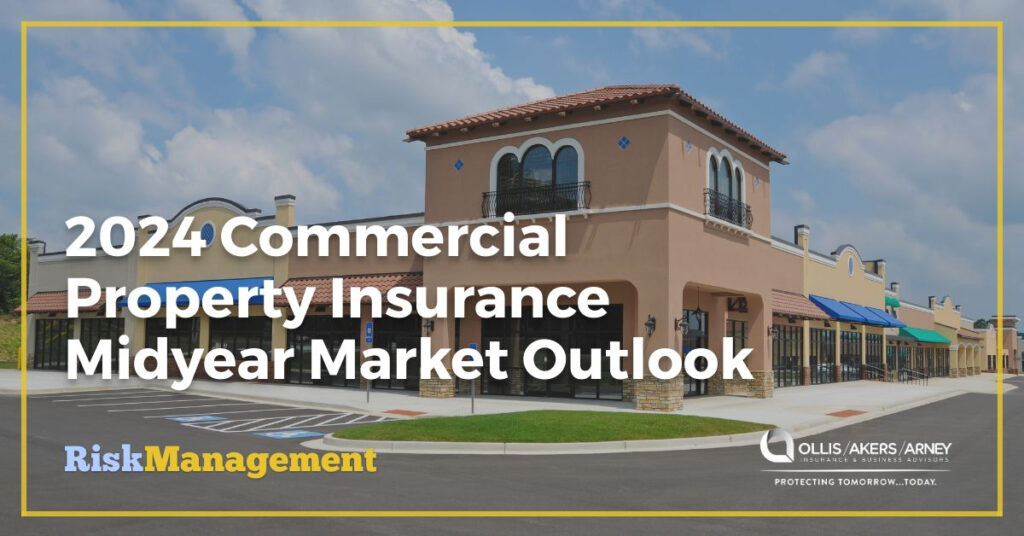The commercial property insurance segment has been characterized by ongoing premium increases for much of the past decade. According to industry data, such rate jumps reached record-setting levels in 2023, surging by an average of 20.4% in the first quarter alone and only slightly falling to 18.3% in the latter half of the year. These conditions are primarily the result of another intense season of natural disasters, inflation issues and an increasingly volatile property valuation landscape. Losses stemming from these trends have forced commercial property insurers to continue increasing policyholders’ premiums and introducing more restrictive coverage terms.
In 2024, these difficult market dynamics have somewhat eased; however, most insureds are still experiencing double-digit rate increases. Industry experts reported that average premium jumps ranged between 10.3% and 10.8% during the first quarter of the year. Looking toward the second half of 2024, existing segment challenges will probably press on, so insureds who conduct high-risk operations, have poor property management practices or are located in natural disaster-prone areas may remain susceptible to continued rate hikes and coverage limitations.
Developments and Trends to Watch
Natural disasters
Extreme weather events often leave behind severe property damage. As such, the growing intensity of these catastrophes has posed concerns in the commercial property insurance segment. According to a recent report from professional services firm Aon, global natural disasters caused $17 billion in insured losses during the first quarter of 2024, representing a major increase from the median of $12 billion for this time period over the past 20 years. In the United States, these losses were largely driven by secondary perils, including severe convective storms (e.g., thunderstorms, hailstorms and tornadoes), winter weather events and flooding. The report found that the country’s most destructive natural disaster of the year thus far involved a series of violent tornadoes and large hail that spread across the Great Plains from March 12-16, totaling an estimated $3.4 billion in insured losses. What’s more, these trends are only expected to worsen as the year goes on. In particular, the National Oceanic and Atmospheric Administration is projecting that unusually warm land and sea temperatures will keep spawning severe storm systems throughout 2024, leading to more tornadoes in an already record-high season and contributing to “above- normal” hurricane activity along the Atlantic and Gulf Coasts. Consequently, natural disaster trends will likely continue to exacerbate commercial property losses and create market difficulties in the future.
Parametric coverage
As natural disasters become more severe, parametric coverage has risen in popularity. Contrary to the reimbursement method of standard commercial policies, parametric insurance offers protection based on a predetermined, measurable characteristic tied to a covered event. Under such coverage, the amount a policyholder is compensated isn’t decided by the exact cost of damages sustained but rather by the calculated intensity of the covered event itself. For instance, if a hurricane caused damage to a commercial property, a parametric policy might reimburse a set dollar amount linked to the storm’s wind speeds. Key advantages of this coverage include the ability to remedy possible property insurance gaps posed by large-scale natural disasters, more timely payouts (often less than three weeks) through the use of simplified proof-of-loss protocols, and greater policy flexibility and transparency. According to industry data, submission volume in the parametric segment has jumped by 500% over the last year, with the market projected to nearly triple in value and exceed $29 billion by 2031.
Tips for Insurance
- Keep your commercial property in good condition at all times and immediately address building issues that could lead to losses
and subsequent claims. Provide all relevant loss control documentation to your insurer. - Analyze your organization’s natural disaster exposures. If your commercial property is located in
an area more prone to certain types of weather and climate events, implement adequate mitigation and response measures. - Discuss with insurance experts how parametric coverage can complement traditional insurance offerings.
This document is not intended to be exhaustive nor should any discussion or opinions be construed as legal advice. Readers should contact legal counsel or an insurance professional for appropriate advice.
© 2024 Zywave, Inc. All rights reserved.


